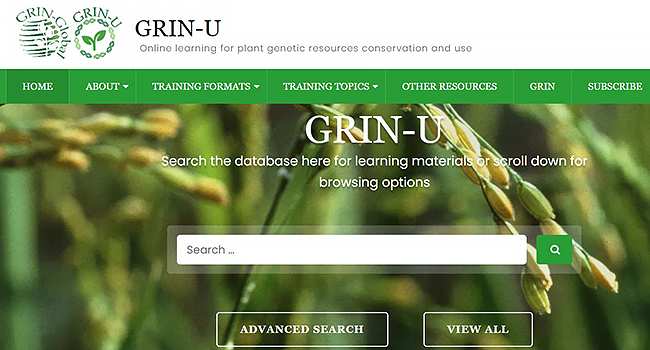Securing Plant Genebank Collections and Providing Educational Resources For Training Opportunities
Contact: Maribel Alonso
Email: Maribel.Alonso@usda.gov
July 7, 2021
How many times have you heard, “it is vital to back up all important information to prevent accidental losses?” Scientists at the United States Department of Agriculture (USDA), Agricultural Research Service (ARS), in Fort Collins, CO, are fully aware of the importance of backing up important material!
The National Laboratory for Genetic Resources Preservation has an important task that involves backing up all collections of plant genetic resources or germplasm (including seeds and plant shoot tips) from the USDA National Plant Germplasm System (NPGS) genebanks as well as from some international sources, and they are sharing outreach information through a new website: GRIN-U.org.
“Genebanking techniques are highly specialized and multi-disciplinary, consequently it is difficult to find training opportunities in university settings. The new GRIN-U website has been released and provides videos, ebooks, and other educational content relating to the conservation and use of plant germplasm,” said Gayle Volk, ARS Research Plant Physiologist. “All of the information presented on the website is freely available for use for on-the-job training, as well as within institutional settings.” Volk is part of a team of scientists and collaborators who developed the GRIN-U website as part of a USDA National Institute of Food and Agriculture Higher Education Challenge Grant.
Preservation of plant germplasm is essential for sustaining and improving food production in a world constantly challenged by changing climate and emerging plant pests and disease. Scientists, geneticists, and plant breeders use diverse genebank collections as sources of valuable traits they can incorporate into new crops. Because our food supply relies on their diversity, it’s only natural that we need to securely back-up these important genebank collections.

The GRIN-U.org website provides educational resources for use in genebank or university settings.
Preserving seeds and tissues at their optimal viability is everything! Did you know that seeds can have different lifespans? With the Agricultural Genetic Resources Preservation Research Unit, Stephanie Greene explains that different species have seeds with different lifespans, partly due to the wide range of habitats where the species evolved. For example, seeds from plants living in wet areas may have developed strategies to survive in environments with high moisture levels.
For long term storage, seed samples are carefully dried to prolong their viability in storage conditions. Once the seeds are dried, scientists perform a germination test to assess the initial viability of the seed lot. This step is essential because highly viable seeds can remain alive for a long time in storage, ready to germinate and grow when needed. In the end, seed lots are packaged in unique foil laminate bags that are moisture-proof, then heat-sealed, labeled, and placed in a storage room as cold as a freezer. Low moisture and cold temperatures slow down the chemical reactions that cause seeds to degrade in storage. Learn more here about this process.
Why preserve other different kinds of plant tissues, such as shoot tips? Volk explained that some crops are propagated by seeds, and thus are appropriately stored in that form. Others are valued for their specific genetic compositions and are propagated by grafting or cuttings. These must be securely backed up as vegetative tissues, such as shoot tips.
ARS’ scientists and researchers will continue to develop new genebanking technologies and share this information to ensure that plant genebank collections are securely maintained and protected within the NPGS. Now, whenever someone asks you to “back up your information,” remember all the valuable work Greene, Volk, and their colleagues are doing at the ARS’ National Laboratory for Genetic Resources Preservation.
The Agricultural Research Service is the U.S. Department of Agriculture's chief scientific in-house research agency. Daily, ARS focuses on solutions to agricultural problems affecting America. Each dollar invested in agricultural research results in $17 of economic impact.
